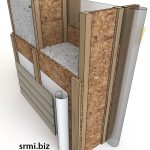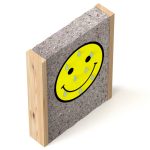The Experimental Findings
Building Science Corporation (BSC) published a recent report that spawned a Journal of Light Construction (JLC) article called “Moisture in Fat Walls”. Two of the three walls studied are double walls with R-values in excess of R-40. The setting for the buildings studied is Massachusetts.
Quoting the article: “Under high interior humidity loading (nonfunctional ventilation system, 40% to 50% interior relative humidity), all test walls showed moisture contents and sheathing-insulation-interface relative humidities well into the high risk range. The cellulose walls showed particularly high moisture contents (sheathing in excess of 30%), while the open-cell spray-foam walls showed moisture contents in the 18% to 25% range. In addition, the monitoring showed evidence of liquid water condensation (which can result in quick degradation) in all walls, and the condensation was substantial in the cellulose walls. These condensation issues occurred on the north and south sides.” BSC
Given these findings, I find one BSC’s conclusion strangely optimistic: “It is entirely likely that many double-stud walls insulated with cellulose with only Class III vapor control provide fine service.” BSC
My Doubts about the Findings
The 50% rh and dysfunctional ventilation system should almost be part of building design because these conditions are so common. The current absence of mold doesn’t give me confidence in these wall cavities. OSB becomes more vapor permeable, hydrophilic, and mold-ready with each wetting. The OSB can expand and lose strength with wetting, like it does on a wet building site. The cellulose closest to the sheathing can shrink leaving an troublesome air cavity and reducing the wall’s R-value. The lack of recognition that wetting can damage both OSB and cellulose, regardless of mold, is an important omission in the JLC article.
The experimental conditions of the past 3 years aren’t worst-case. What about increasingly common weather events, like Superstorm Sandy and New England’s recent super snowstorms, which leave the water table high, the outdoor air humid, and buildings wet for months on end?
Massachussetts, like much of the Northeast can be cold and wet, with occasional driving rain and snow. These experimental walls would have benefited from a pressure-equalized rain screen, which would minimize external wetting and increase the drying rate.
Comparing Insulation Products for Wet Climates
As for practical matters, open-cell foam costs at least twice as much as blown cellulose, fiberglass batts, or rockwool batts installed ($3 vs $6/sf). There lingers a false assumption that the airtightness of low-density foam or cellulose compared to mineral wool is somehow a factor. Really, none of these insulation materials is an sufficient air barrier. However wall sheathing definitely is an air barrier and there are several methods of making the wall extremely airtight using the sheathing. So why favor open-cell foam or cellulose over mineral wool? Foam, installed to 6-or-12-inch thickness, can contain flaws including hockey-puck-sized bubbles, and it is famous for shrinking over the years.
The cost of cellulose versus blown mineral wool or batts is negligible. The foam must be nearly double the cost the fiber insulations. The R-values are roughly comparable with the advantage going to the mineral wool (more than R-4 per inch at high density versus less than R-4 for the cellulose and open-cell foam.). Given the choices for the Northeast, I’d pick mineral wool for walls because it’s economical, non-organic, minimally-absorbent (around 5% compared to more than 100% water by weight), and it drains. I’d install the smart vapor barrier to minimize the vapor diffusion into the wall.
My Conclusion
In a cold climate like New England, believing that cellulose or open-cell foam will somehow manage the moisture admitted through a Class III vapor retarder or prevent mold in the presence of wetness seems incredibly optimistic to me.


